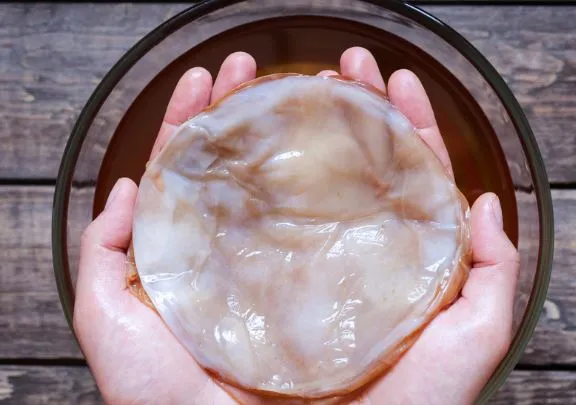What does Kombucha Taste Like – Kombucha first gained fame in the 1990s, but it is in recent years that it has become a mass phenomenon. Our boat is also proof of this: “Kombucha” is one of the most sought-after terms in the store, and the bottles of this fermented tea are sold in batches. However, many, myself included, were not so clear what kombucha is, what is real. So I started to try and investigate. I start by the conclusion: the kombucha is a unique product and very, very interesting.

What is kombucha?
Kombucha is, in essence, the sum of four ingredients: tea (green, black or white), sugar, water, and SCOBY. To me, the word SCOBY sounds like a cartoon LOL, but it is something, referring to its appearance, rather less sympathetic.
SCOBY is the acronym for Symbiotic Colony of Bacteria and Yeast or, as we would say in Spanish: ” Symbiotic Colony of Bacteria and Yeast “. Which translates into a rubbery, slippery mass that releases brown trickles. Honestly, its not very appetizing, but, speaking of kombucha, the scoby is everything.

This colony of bacteria and yeast feeds on sugar. Then, the tea begins to ferment, and it is at that moment when it acquires its particular flavor and all the probiotic organisms for which it is worshiped.
In an unfiltered kombucha, well see Scoby floating on top of the liquid, like a gelatinous layer that protects the fermented tea from external agents and helps maintain a very specific ecosystem in there. Interesting, right?
What does kombucha taste like?
The kombucha is mainly acid and with a slight sweet flavor . Sometimes, it is described as “sour” or reminiscent of apple cider.
Right from the start, the taste of this probiotic drink in its pure state may not be entirely pleasant, although the taste of the first few times ends up becoming a pleasure. Above all, if you imagine all those microorganisms working to make your body a healthier place. In addition, most brands add other ingredients that provide natural flavors and adapt the taste of kombucha to our palate. In this way, in a drink of kombucha, you will perceive fruity, herbaceous, citrus, spicy or floral notes, for example.
Another important characteristic of our fermented tea is that it is bubbly, like a very soft soda. In a natural way, the scoby adds a certain level of effervescence to the kombucha, but sometimes it is carbonated to the elderly through other processes.
Some more data
- It is believed that kombucha had its beginning thousands of years ago in China. However, its origins are uncertain.
- One of the most widespread theories about its etymology points to Japan. According to this theory, “kombucha” could come from the Japanese terms “konbu” (alga) and “cha” (tea). That is, “seaweed tea”. It is speculated that the scoby floating in the liquid could remember an alga. However, kombucha refers to another product that has nothing to do with our fermented tea. In Japan, kombucha is called kocha kinoko. It is likely that someone, at some point, marked a lost in translation with this theory.
- Because of fermentation, kombucha tends to have very low levels of alcohol content, between 0.5 and 3%.
- Kombucha can be prepared at home, although it is necessary to take certain safety measures to be certain that our probiotic drink is 100% safe.
- The scoby is also known as “mother”. As it develops, it expands and divides into smaller discs. Many people dedicated to the cultivation of kombucha call these divisions “babies.” In the United States, some kombucha fan communities encourage names of their offspring, such as ” Misha-the-Mushroom and Lewellyn-of-Laurel-Farms .”
But, Nothing better to know what is kombucha than to taste it, Right?
